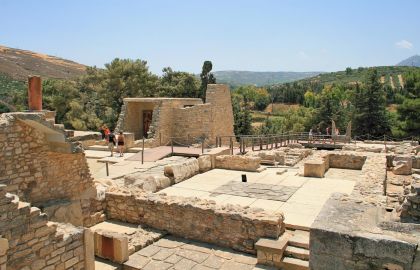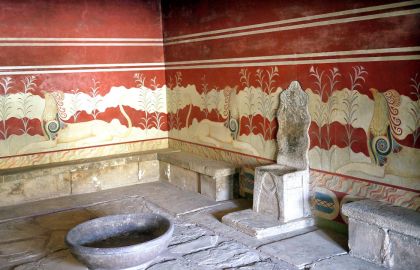!--carousel(2120)--!
Knossos is the most famous of the palaces of the Minoan civilization. It was destroyed possibly by a volcanic eruption about 1450 BC. The ancient Knossos was the hub of the Minoan Civilization which imposed the Aegean 4000 years ago. According to mythology, the palace was the seat of the king Minos. It is also connected with intriguing legends, such as the myth of the Minotaur in the Labyrinth under the Palace, and the story of Daidalos and Ikaros. Minos Kalokerinos did the first excavations of the site in 1878. However, Sir Arthur Evans was the archaeologist who did the complete excavations of the site (1900-1913 and 1922-1930).
The old (first) palace was built around 2000 B.C. but it was completely destroyed by an earthquake in 1700 B.C. The new (second) palace was built immediately on the ruins of the old one and it was more complex in plan, like a labyrinth. In the middle of the 15th century B.C. when the Achaeans from the Greek Mainland conquered Crete it was partially destroyed. The palace was finally destroyed again by fire (Santorini Volcano) in the mid-14th century B.C. Sir Arthur Evans managed to extensively reconstruct the Palace of Knossos.
 The Palace of Knossos is the largest and the most spectacular of all the Minoan palatial centres. The Palace spread over 20,000 square meters (2 hectares) of land with heights reaching four stories. It was constructed in a labyrinth-like pattern and it provided housing for about 100,000 people. Colourful friezes and frescoes, figures and paintings on plaster fill the walls of the palace and exhibit life from this era. There are varying pictures from animals and people to gods and various ceremonies, which depict an advanced and sophisticated society. Further examination of the Palace''s interior decoration reveals that war was not a common theme and women were depicted almost as frequently as men.
The Palace of Knossos is the largest and the most spectacular of all the Minoan palatial centres. The Palace spread over 20,000 square meters (2 hectares) of land with heights reaching four stories. It was constructed in a labyrinth-like pattern and it provided housing for about 100,000 people. Colourful friezes and frescoes, figures and paintings on plaster fill the walls of the palace and exhibit life from this era. There are varying pictures from animals and people to gods and various ceremonies, which depict an advanced and sophisticated society. Further examination of the Palace''s interior decoration reveals that war was not a common theme and women were depicted almost as frequently as men.
The variety of building materials used and the marble revetment show an advanced level of technology. This is also demonstrated by some architectural and structural features, such as the light-wells and the complex drainage and water-supply systems.
 The palace is set around a large Central Court, which was used for public meetings. A second courtyard, the West Court, was used both as the official approach to the palace and a ceremonial area. In the west wing there are the official rooms for administrative and religious activities; the Tripartite Shrine, the Sacred Repositories and the Pillar Crypts; the Throne Room is outstanding among them. The most important areas in the south wing are the South Propylon, the Corridor of the Procession and the South Entrance, with the fresco of the Prince of the Lilies. The east wing contained the residential quarters and large reception rooms, the most important being the Hall of the Double Axes and the Queen''s Hall. These rooms are approached by the imposing Grand Staircase. From the North Entrance, a road led to the harbour of Knossos. The North Entrance is flanked by elevated stoas, the west one being decorated with the Bull Hunt fresco. The stone-paved Royal Road led from the Small Palace and the city to the North-west corner of the palace, where there was an open-air theatrical area.
The palace is set around a large Central Court, which was used for public meetings. A second courtyard, the West Court, was used both as the official approach to the palace and a ceremonial area. In the west wing there are the official rooms for administrative and religious activities; the Tripartite Shrine, the Sacred Repositories and the Pillar Crypts; the Throne Room is outstanding among them. The most important areas in the south wing are the South Propylon, the Corridor of the Procession and the South Entrance, with the fresco of the Prince of the Lilies. The east wing contained the residential quarters and large reception rooms, the most important being the Hall of the Double Axes and the Queen''s Hall. These rooms are approached by the imposing Grand Staircase. From the North Entrance, a road led to the harbour of Knossos. The North Entrance is flanked by elevated stoas, the west one being decorated with the Bull Hunt fresco. The stone-paved Royal Road led from the Small Palace and the city to the North-west corner of the palace, where there was an open-air theatrical area.
Around the palace the Minoan settlement extended with the cemeteries on the hills. Some more important buildings are the followings; the South House, the House of the Chancel Screen, the Small Palace, the Caravanserai, the Royal Villa and the Temple-Tomb. The Villa Dionysos with its floor mosaics (2nd AD) is an important building of the Roman period. All the impressive finds of the palace (pottery, vessels, figurines, the archive of Linear B tablets, and the original wall-paintings) are housed in the Herakleion Museum.
Useful Tips:
It is better to visit Knossos in spring or autumn, since the cooler weather will make it easier to explore the site. However, if you visit Crete in the peak of summer try to be in the site in the first morning hours. There are a few tavernas and snack bars near the entrance on the road to Heraklion.


